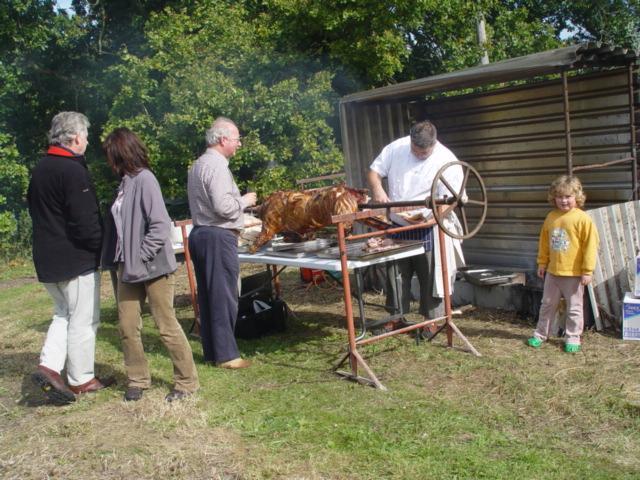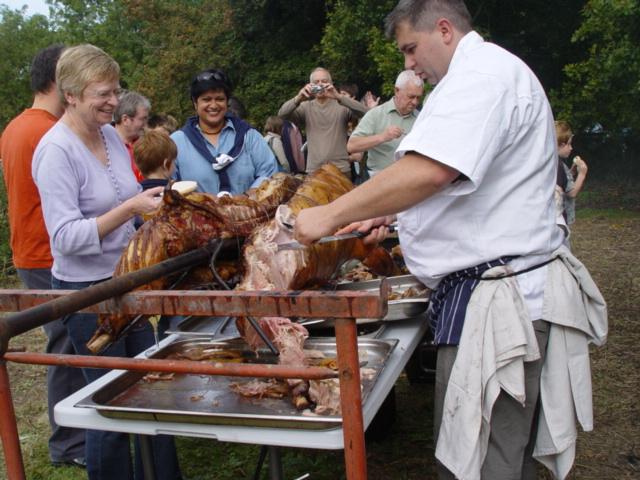
jackal10
participating member-
Posts
5,115 -
Joined
-
Last visited
Content Type
Profiles
Forums
Store
Help Articles
Everything posted by jackal10
-
I have, many times 1, A pig has most of its weight at both ends, so build two small fires with nothing, or only the gravy pan in the middle. 2. You are aiming for an end temperature in the centre of the thickest part (the butt) of at least 60C/140F 3. Build an enclosure to keep the heat in, so it acts like a slow oven. Here I used aluminium siding and a couple of builders trestles 4. I serve with in a hamburger bun with sage and onion stuffing and apple sauce. The stuffing (Paxo, made from a packet but with more water) helps the meat go further 5. Reckon 1 lb whole pig weight per person. There is a lot of waste and inedible bits - bones, etc. Make brawn from the head 6. Organise a production line to serve - on person carving, others stuffing buns and adding sides. Enjoy!
-
I've no objection if another party does it, especially in a way that does not disturb other diners, for example no louder than normal conversation. I do find it (silently) embarrasing when my host does it and expects me to join in, or a guest at a table I'm hosting.
-
Never, except at high table in College where latin grace is a traditional ritual. What do you do when your host says grace? Personally I just remain silent, rather than start an argument about their beliefs. (Restauranters's grace: "Oh Lord give us power To shift this lot in half an hour")
-
I have a brief work trip to Changshu, Nanjing and Zhengzhou but only 2 days in each in early July Assuming there is any spare time what should I eat or see? Night markets, since I suspect days will be busy. Thanks
-
Crude temperature control - you can turn the burner up or down, or increase the draught in solid fuel ones but there is a long lead time in response. Temperature control is by which oven or hotplate you use In principle Roasting Oven Hot Approx. 240-260° C 475-500° F Gas Mark 8-9 Baking Oven Moderate Approx. 180-200° C 350-400° F Gas Mark 4-6 Simmering Oven Slow Approx. 115-135° C 225-275° F Gas Mark 1 Warming Oven Warm Approx. 60-70° C 140-160° F Gas Mark 1/4 HOwever temperatures can vary by quite a bit if thr cooker has been heavily used, or the insulating lids left open I believe the more modern ones have electronic control. AGAs last forever. Mine is a 1930s model coal fired model converted to oil.
-
Its on all the time. Its a stored heat cooker - over half a ton of cast iron in a highly insulated box, heated by a small flame or other energy source, or even solid fuel. It takes maybe 12 hours to get up to heat, and then outside is just warm to touch, so it heats the kitchen a little Good to snuggle up to on cold mornings - it becomes the centre of the house. Costs are around £15/week to run.
-
If you have a 4 oven AGA the coolest oven (plate warming) is at about 60C ideal for cooking beef, or at least mine is. \you can regulate the temperature a little by opening the door a crack. I usually cook it for 12 hours covered in a sheet of tinfoil to an end temperature of 58C. Sear before (for flavour) and after (for crispness). You will have beef of unparalled succulence. Meantime you will want to roast potatoes,parsnips, onions, carrots and cauliflower etc in the hot oven, (they hold in the cool oven) and quickly cook green veg on top for service. Not forgetting the Yorkshire Puds (bottom of the top oven for 1/2 hour - they rise better with lots of bottom heat) The lower oven of the 2 oven AGA is too hot to do long term cooking for rare beef. Roast conventionally in the top oven. A digital themometer will make it much easier to determine the end point, but I would guess about 45 minutes, depending on thickness and how rare you like your beef. Then let it stand, covered, on top or in a warm palce for 45mins to let things even out (while you cook the yorkshires).
-
Ahh, AGA toast. For those who don't know, AGA toast is made using the AGA toaster http://www.agacookshop.co.uk/tools/aga-tools/aga-toaster.html sandwiched between the boiling plate at 800F/450C and its insulating cover. Its almost contact grilling. It makes toast crip on the outside, but soft in the middle like no other. I guess you might make something similar on a flatplate or flat griddle covered with a heavy pre preheated lid.
-
Dougal is right http://www.danlepard.com/forum/viewtopic.php?f=3&t=6&p=28
-
Sounds like you are suffering from a "flying crust". The top crust drys and stays inflated, but the crumb collapses underneath it a) Reduce the final proof time, maybe by half. You want most rise as oven spring. b) Make sure the cust doesh't dry out during proof, for example by proving in a plastic bag, or covered racks c) Turn the loaves over before baking so the dryer crust is underneath
-
Digital thermometer with a probe that can be left in the oven Digital scales
-
Gummy whole wheat bread: troubleshooting for a better loaf
jackal10 replied to a topic in Pastry & Baking
Yes, it oxidises an enzyme that degrades gluten in fresh flour. Leaving the flour for a month or three before using oxidises the enzyme from the oxygen in the air. The plant uses it to stop the gluten gumming up when trying to grow, so sprouting will generate lots of enzymatic changes. -
Gummy whole wheat bread: troubleshooting for a better loaf
jackal10 replied to a topic in Pastry & Baking
How soon after baking did you cut it? You ned to leave the bread at least an hour to cool and setup, otherwise it will be gummy. I think enzyme activity is the problem. Try adding a pinch of vitamin C -
eG Foodblog: Pam R (2011) - Passover Part III
jackal10 replied to a topic in Food Traditions & Culture
Sinkers, flavoured with parsley and fried onion in them for me -
Cut in half either side of the flat stone Score the flesh both ways into 1cm cubes Press in the middle of the skin side - Sort of turn it inside out, so the skin is concave instead of convex Pick off the cubes
-
Can you reccomend Bistrot and the like in the 5th and 6th Arrondisments. We are going for a long weekend and looking for informal dining "like the old Polidor"
-
Lancashire hotpot (best end of neck or scrag of lamb stewed with onions and potatoes) Lamb curry Boned stuffed and rolled shoulder lamb liver wth bacon, or onion lamb kidneys with sherry and mustard lamb heart (stuffed, braised) Donar kebab boiled leg (better with mutton) scotch pies (minced lamb in pastry and gravy)
-
eG Foodblog: Pam R (2011) - Passover Part III
jackal10 replied to a topic in Food Traditions & Culture
Chag Samauch, and why is pesachtikka cheese (here in UK its only Dutch Gouda) so bland and soapy? -
There are several different types of sorrel with different leaf shapes. I grow traditional (schav), red-veined and buckler leaved. Sorrel is really quite acid, as the leaves contain mildly poisonous oxalic acid. Spinach plus some acidity (lemon juice or a good white vinegar) would substitute. However inevitably the would be not quite the same, but then you would be making your own version of the dish,
-
"Modernist Cuisine" by Myhrvold, Young & Bilet (Part 3)
jackal10 replied to a topic in Cookbooks & References
Anyone notice the distinctive smell of the books? I guess its the ink solvent... -
UK, mostly amateur. Listmaster of molecular-gastronomy@googlegroups.com
-
"Modernist Cuisine" by Myhrvold, Young & Bilet (Part 3)
jackal10 replied to a topic in Cookbooks & References
It's arrived! Now to find where to keep it... -
That is a pretty wet dough - 24oz total water to 27.5oz total flour, about 87% hydration, almost a batter. That will give bigger holes, but wetter thick walled crumb. Normal bread is in the 55% to 70% range. You might want to cut the water in the dough step down to 10oz - about 65% hydration, and stretch and fold twice say every 15 mins.
-
From looking at the pictures I'd guess it was over proved, and under baked. That would also explain the "flying crust". Looks good tasting sandwich bread anyway. What happens is the dough expands beyond its optimal point and collapses a bit but the crust has dried some and stays..The big hole in the middle is from a moulding fault (press harder when shaping), but doesn't matter It also looks a but wet, from the way its curled over the tin, but proving less will also help that - dough gets less viscous as it proves. AP flour is OK, and for some breads I prefer it, but it may take less water. The stated protein content of whole wheat flour is not the gluten content, as the bran contains some protein. I guess this is a single rise bread, that is having kneaded and formed it you put it straight in the tin and let it rise. Next time cut the final rise time, by say an hour or even an hour and a half, and let it rise in an oiled plastic bag, such as a garbage bag. A loaf will naturally get tighter towards the bottom, but if the crumb is wet and pudding like it may indicate baking at too high a temperature, or with not enough bottom heat. Did you bake it on a preheated pizza stone or tiles? Jack
-
eG Foodblog: haresfur (2011) - not exactly bush tucker
jackal10 replied to a topic in Food Traditions & Culture
I'd cook the lentils seperately, as you should be cooking the shanks at a lower temperature (75C) which is not enough to cook the lentils or veg.



